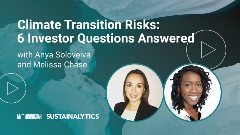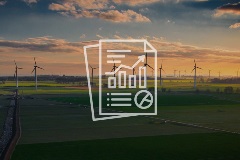What are the Key Themes Driving Investor Climate Reporting?
In the context of the climate crisis, investors need insightful climate research, ratings, and data. Investors must balance the physical risks of climate change alongside the transition risks of moving to a net-zero economy.
In particular, regulatory guidance like the Task Force on Climate-related Financial Disclosures (TCFD) has placed urgency on the investment community to take a more active role to address global climate change. The TCFD framework is becoming increasingly important as it is shifting from a voluntary approach to being the main global regulatory response to climate risk, with many regions now mandating it for compulsory climate reporting.
Featured Content

eBook | Managing Risks for a Changing Climate: A Guide for Institutional Investors
Is your organization planning on or has committed to aligning portfolios to a net-zero pathway and must report on decarbonization efforts? Read our latest ebook for insights into the investment and portfolio risks related to physical climate hazards and the transition to a low carbon economy.
Climate Content
Six Best Practices Followed by Industries Leading the Low Carbon Transition
In this article, we take a closer look at the leading industries under the Morningstar Sustainalytics Low Carbon Transition Rating (LCTR) and examine the best practices that have allowed them to emerge as leaders in managing their climate risk.
Navigating the EU Regulation on Deforestation-Free Products: 5 Key EUDR Questions Answered About Company Readiness and Investor Risk
The EUDR comes into effect in December 2024, marking an important step in tackling deforestation. In this article, we answer five key questions who the EUDR applies to, how companies are meeting the requirements, and the risks non-compliance poses to both companies and investors
Beyond 1.5 Degrees: What the LCTR Tells Us About Companies Managing Their Climate Risk
The LCTR rating of over 8,000 companies shows that global temperatures will rise 3.1 degrees Celsius over pre-industrial averages. This article looks at the overall performance of these companies and the industries that are leading on climate.
The SEC’s Climate Disclosure Rule: A Step in the Right Direction
The U.S. Securities and Exchange Commission (SEC) recently published the final version of its long-awaited Climate Disclosure Rule. The final rule differs significantly from its original draft and further departs from other standards about to be implemented around the globe.
Double Trouble: The Rise of Greenwashing and Climate Litigation for Banks
The fight against greenwashing is being taken to the courts. An analysis of Morningstar Sustainalytics data shows a 12-fold rise in climate-related litigation, including greenwashing claims, against banks over the past three years.
Climate Transition Risk: 6 Investor Questions Answered
This video interview provides insight into the challenges institutional investors face as they struggle to comply with the growing slate of climate-related reporting frameworks and standards, while trying to identify, manage and mitigate climate transition risks in their portfolios.
Our Solutions
Morningstar Sustainalytics’ Climate Solutions enable investors to effectively evaluate both transition and physical climate risks. Our products can help investors build comprehensive climate investment strategies, fulfill disclosure requirements, advance engagement activities, and evaluate climate risks.

Physical Climate Risk Metrics
Assess and disclose the direct and indirect physical climate risks of climate change related exposure.
Learn More
Low Carbon Transition Ratings
Receive a forward-looking assessment of a company’s current alignment to a net-zero pathway.
Learn More
Carbon Emissions Data
Evaluate and analyze companies’ GHG emissions across scope 1, 2, and 3 emissions.
Learn MoreAdditional Resources
Net-Zero Transition
Low Carbon Transition Ratings from Morningstar Sustainalytics
In the context of the climate crisis, investors need robust research, data, and tools to identify and manage the climate transition-related risks and opportunities of their portfolio companies. Morningstar Sustainalytics’ Climate Solutions team created the Low Carbon Transition Ratings (LCTR), a new flagship ratings product, to help investors do just that.
Low Carbon Transition Ratings Methodology
Leveraging our Low Carbon Transition Ratings, investors can respond to regulatory initiatives, implement net-zero strategies, fulfill client net-zero mandates and obtain transparency into company actions by integrating climate research into their investment decision-making processes.
Physical Climate Risks and Carbon Emissions
Brochure | Physical Climate Risk Metrics
As climate change challenges the modern investment landscape, evolving marketplace expectations will require investors to disclose both transition and physical climate risks associated with their investments. To help investors better understand their exposure to physical climate risks, Sustainalytics, in collaboration with XDI, an award-winning global leader in physical climate risk analysis, are introducing Physical Climate Risk Metrics (PCRM) as Sustainalytics’ first Physical Climate Risk offering to align with evolving reporting needs. XDI's analysis supports decision-making in finance, business, and governments worldwide, with detailed, investment-ready information for physical climate risk.




-5-key-questions-answered-about-company-readiness-and-investor-risk.tmb-thumbnl_rc.jpg?Culture=en&sfvrsn=ee2857a6_2)

















